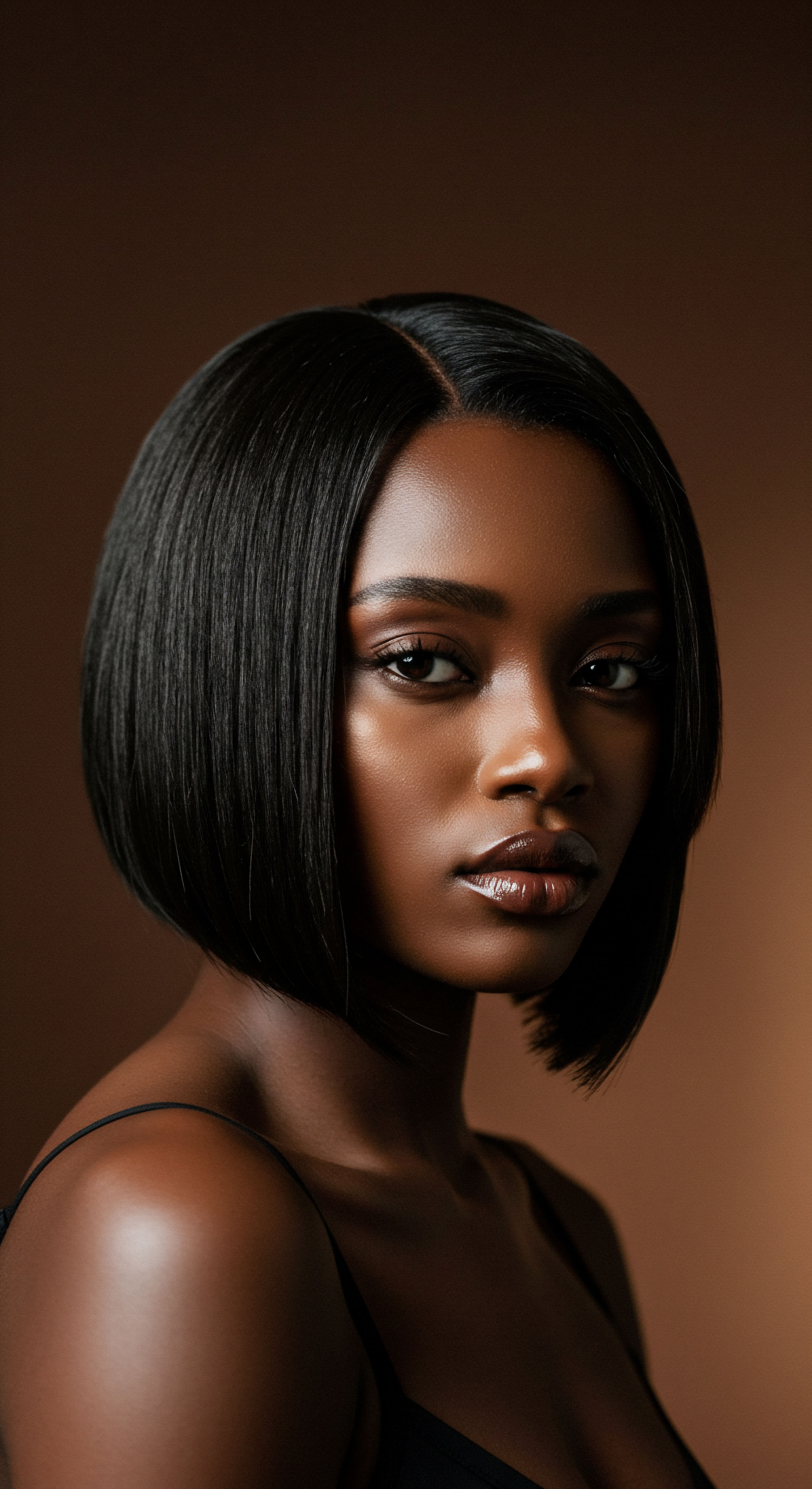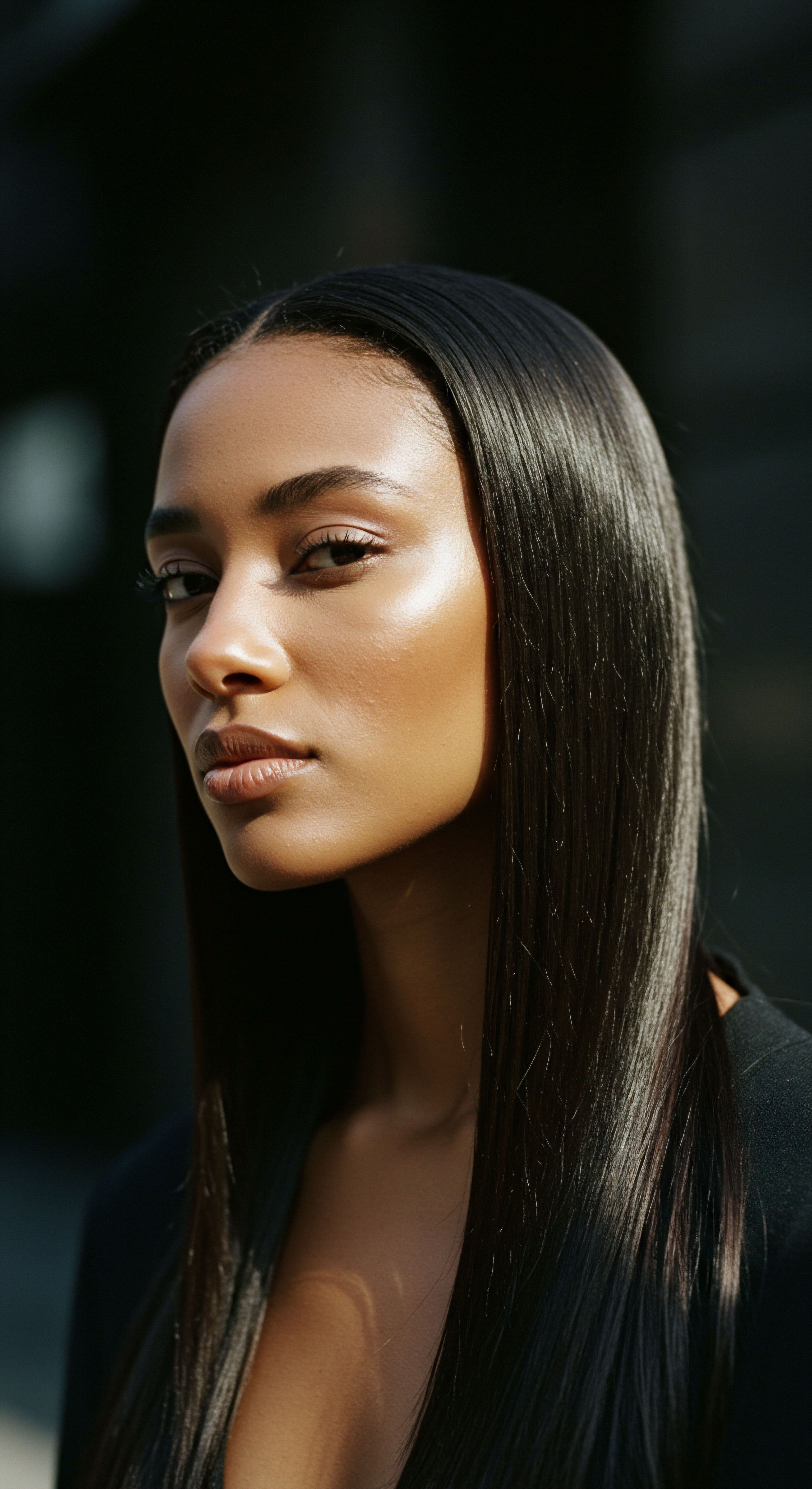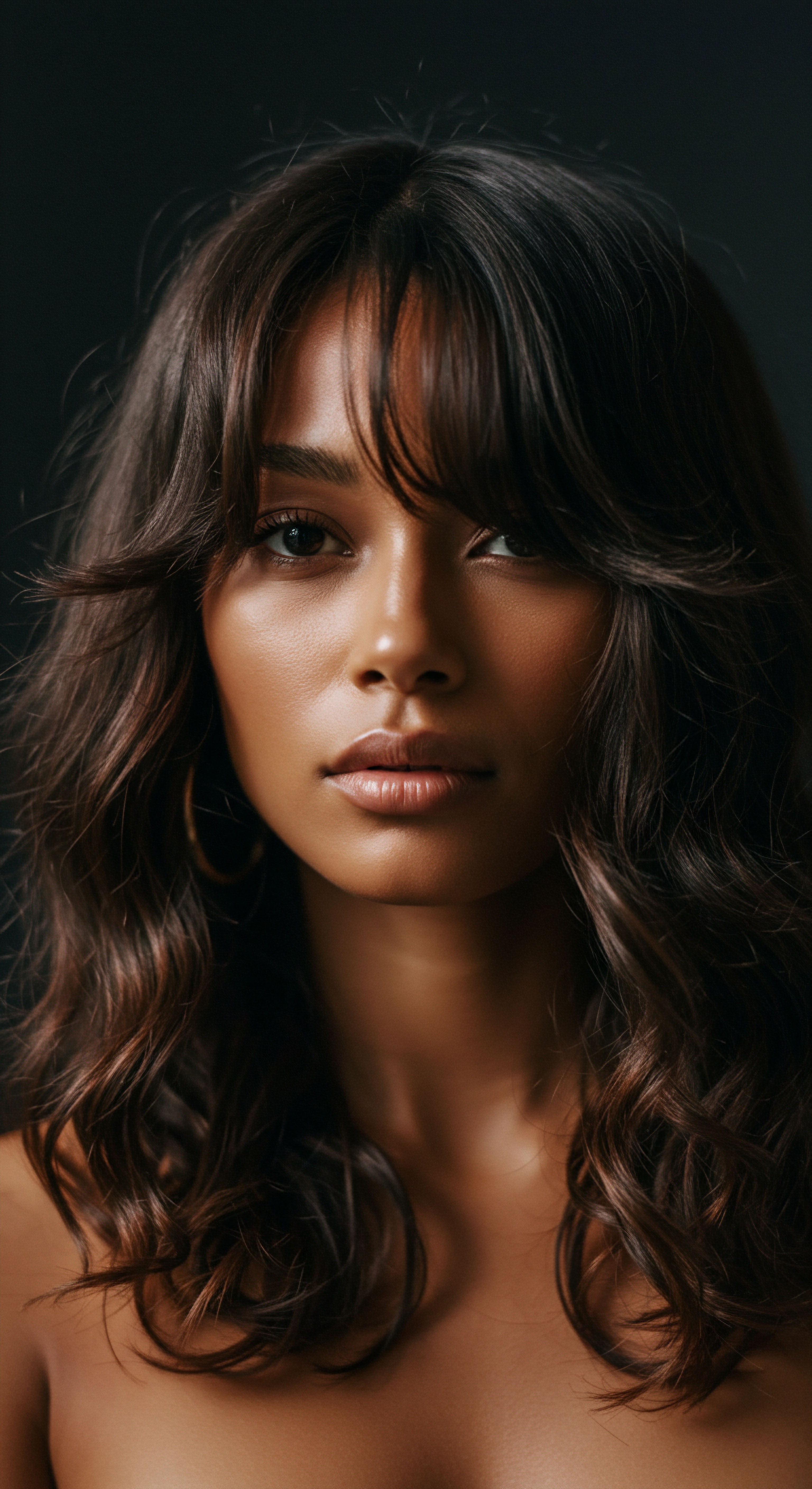
Roots
The whisper of ancient sands often carries secrets, and among them, the enduring practices of hair care in the land of the pharaohs stand as a testament to human ingenuity and a deep connection to self-presentation. It is a quiet observation, perhaps, that even in the earliest chapters of recorded history, the desire for healthy, well-tended hair was a universal thread, a personal expression woven into the very fabric of daily life. For the ancient Egyptians, hair was far more than mere adornment; it was a symbol, a shield, and a canvas for societal identity, demanding a regimen of care that blended natural resources with remarkable sophistication.
Our journey into this ancient world begins with understanding the fundamental relationship between the Egyptians and their hair. Their environment, the scorching desert sun, and the ever-present threat of pests, profoundly shaped their approach to hair maintenance. This wasn’t merely about vanity; it was about hygiene, protection, and a visual declaration of status. The rich historical record, from tomb paintings to surviving artifacts, provides glimpses into a culture where hair, whether natural or artfully crafted, held immense significance.

What Did Ancient Hair Really Look Like?
When we consider the hair of ancient Egyptians, our minds might conjure images of smooth, dark, and perfectly coiffed wigs seen in hieroglyphs. While these artistic renderings offer valuable insight, they present an idealized view. The reality of ancient Egyptian hair, much like hair today, was diverse. Archaeological findings, particularly the analysis of mummified remains, reveal a spectrum of hair textures and colors.
While many Egyptians possessed dark brown or black hair, some mummies, such as that of Ramesses II, exhibit naturally reddish tones, a discovery confirmed by microscopic examination of hair roots. This diversity suggests that their care practices needed to address a range of natural hair characteristics, much like our understanding of textured hair today.
The ancient Egyptians understood hair as a living fiber, susceptible to environmental stressors. They recognized the need for cleansing, conditioning, and protection. Their understanding of hair anatomy, while not informed by modern microscopy, was practical and effective.
They observed how hair could become dry, brittle, or prone to infestation, leading them to develop remedies and preventative measures. This foundational knowledge, born from keen observation, laid the groundwork for their extensive hair care repertoire.
Ancient Egyptian hair care, driven by a desire for hygiene and social expression, transcended mere aesthetics, reflecting a deep understanding of hair’s intrinsic nature.

The Elemental Components of Ancient Hair Care
The arid climate of Egypt meant that moisture retention was a constant concern for both skin and hair. This environmental factor directly influenced their choice of ingredients. Natural oils and fats formed the bedrock of their hair conditioning and styling. These substances provided a protective barrier against the sun and helped to keep hair pliable.
- Castor Oil ❉ A thick, conditioning oil, widely used to add shine and strength. It was a staple in many hair preparations, often blended with other ingredients to create masks.
- Almond Oil ❉ Known for its softening properties, almond oil contributed to the smooth, luxurious feel of the hair.
- Moringa Oil ❉ Derived from the moringa tree, this oil was also a common component in their beauty and hair preparations, valued for its nourishing qualities.
- Animal Fats ❉ Scientific analysis of hair from mummies has revealed the use of fat-based substances, often containing long-chain fatty acids like palmitic and stearic acids, which functioned as styling products to hold hair in place.
- Beeswax ❉ Frequently used, particularly for wigs and hair extensions, beeswax provided structure and a lustrous sheen, helping to set elaborate styles.
Beyond oils and fats, other natural elements played a part. Henna, derived from the Lawsonia inermis plant, was a popular hair dye, primarily used to cover graying hair and to impart a reddish tone. This natural pigment interacted with the keratin in the hair, providing a lasting color.
| Ingredient Castor Oil |
| Primary Function Moisturizing, strengthening, shine |
| Historical Evidence Archaeological findings, texts |
| Ingredient Animal Fats |
| Primary Function Styling, hold, preservation |
| Historical Evidence Chemical analysis of mummy hair |
| Ingredient Henna |
| Primary Function Hair dye, conditioning |
| Historical Evidence Mummy hair analysis, historical accounts |
| Ingredient Beeswax |
| Primary Function Styling, setting wigs, adding luster |
| Historical Evidence Analysis of wigs, tomb depictions |
| Ingredient These ingredients were carefully selected from their environment to meet diverse hair care needs. |
The deliberate selection and combination of these natural elements speak volumes about their sophisticated understanding of hair’s needs. They weren’t simply applying substances; they were crafting formulas designed to cleanse, protect, and enhance, a practice that echoes through modern hair care principles.

Ritual
Stepping from the foundational knowledge of ancient Egyptian hair care, we now consider the daily rhythms and ceremonial practices that shaped their hair journeys. The approach to hair was deeply personal, yet also communal, a daily or periodic practice that intertwined with their cultural identity and societal roles. It was a realm where practical hygiene met artistic expression, where the ordinary became extraordinary through meticulous attention.
The act of caring for hair was not a fleeting thought; it was a considered ritual, a moment of connection with oneself and with the prevailing aesthetic standards. Whether preparing for a bustling day along the Nile or for an eternal slumber, the methods applied to hair were precise, often involving specialized tools and skilled hands.

What Daily Hair Practices Did Egyptians Perform?
Cleanliness was paramount in ancient Egypt, extending to personal grooming. While the exact frequency of hair washing remains debated, evidence suggests regular cleansing was practiced. They likely used substances that acted as early forms of soap, often mixtures of alkaline salts and oils, to purify the hair and scalp.
This commitment to hygiene was not merely for comfort; it was also a defense against lice and other pests, which thrived in the warm climate. Shaving the head entirely was a common practice, particularly among priests, who sought ritual purity and freedom from such nuisances.
Once cleansed, hair was conditioned and styled. Oils like castor, almond, and moringa were massaged into the hair and scalp, providing moisture and a healthy sheen. These oils also aided in detangling and making hair more manageable, a timeless concern for any hair type.
Combs, crafted from wood, bone, or even ivory, were essential tools for distributing these oils and styling. Some combs were dual-sided, while others featured elaborate animal motifs, hinting at their ceremonial or personal significance.
Daily hair practices in ancient Egypt blended rigorous hygiene with artful styling, reflecting a societal value placed on both purity and personal presentation.

The Art of Ancient Styling and Adornment
Ancient Egyptian hairstyles were remarkably diverse and often dictated by social status, age, and gender. Children typically wore a “side-lock of youth,” a distinctive braid or tress left on one side of an otherwise shaven head, a symbol of childhood that appeared in art and even on depictions of deities. Men often kept their hair short or shaved, though more elaborate styles, sometimes involving curls, were also present. Women’s hairstyles were particularly varied, ranging from short bobs in the Old Kingdom to long, elaborate styles in the New Kingdom, often featuring braids, plaits, and curls.
The creation of these styles involved a variety of tools and techniques. Metal implements resembling curling tongs have been found, suggesting the use of heat to shape hair. For hold, a fat-based styling product, akin to a modern hair gel, was applied. This substance, composed of long-chain fatty acids, ensured styles remained in place, even in the afterlife.
Adornment played a significant role in enhancing these hairstyles.
- Wigs ❉ Perhaps the most iconic aspect of ancient Egyptian hair culture, wigs were worn by both men and women across all social classes, though their quality varied. Made primarily from human hair, sometimes supplemented with plant fibers or sheep’s wool, wigs served multiple purposes ❉ protection from the sun, a barrier against lice, and a statement of social standing. Elite wigs were intricate, often braided into hundreds of small plaits and set with beeswax and resin.
- Hair Extensions ❉ Used to add length and volume to natural hair, extensions were also a common practice, with early examples dating back to around 3400 BCE.
- Adornments ❉ Ribbons, beads, flowers, and even precious jewels were woven into hair or wigs. Gold wig rings and diadems made of gold, turquoise, and garnet have been discovered, indicating the opulence of elite hair decoration. Poorer individuals used simpler adornments like petals and berries.
| Tool Combs |
| Material Wood, bone, ivory |
| Purpose Detangling, distributing oils, styling |
| Tool Razors |
| Material Stone, copper, bronze |
| Purpose Shaving heads and body hair |
| Tool Hairpins |
| Material Bone, ivory, wood, metal |
| Purpose Securing hair, styling support |
| Tool Curling Tongs |
| Material Metal |
| Purpose Creating waves and curls |
| Tool These tools facilitated a wide range of styles, from simple to highly elaborate. |
The deliberate and artistic approach to hair styling, whether through natural hair or wigs, underscores the cultural importance placed on appearance. Each curl, braid, or adornment was a piece of a larger story, communicating identity, status, and a connection to the aesthetic ideals of their time.

Relay
How did ancient Egyptian hair care extend beyond daily routines, weaving into the deeper cultural and scientific understandings of their civilization? This question invites us to consider the profound interplay of biology, belief, and social structure that shaped their relationship with hair. It moves us beyond surface-level observations into a realm where hair became a conduit for spiritual connection, a marker of societal standing, and even a subject of early scientific inquiry. The insights gleaned from archaeological science allow us to connect ancient practices with enduring principles of hair health.
The ancient Egyptians viewed hair as possessing a vital force, a source of power and protection. This perception influenced not only their daily care but also their funerary practices, where hair was often preserved with meticulous attention, sometimes even styled for the afterlife. This holistic view of hair, encompassing its physical, social, and spiritual dimensions, offers a rich context for understanding their methods.

The Spiritual and Social Resonance of Hair
In ancient Egypt, hair was imbued with significant spiritual and magical properties. It was considered a symbol of vitality and power, capable of protecting individuals, particularly children and the deceased, from unseen forces. Locks of hair were sometimes used in rituals or deposited in tombs as offerings, suggesting a belief in their enduring power even after separation from the body. For instance, a box containing a lock of Queen Tiye’s hair was found in Tutankhamun’s tomb, indicating the personal and perhaps spiritual value placed on such relics.
Hair also served as a clear indicator of social status and identity. The elaborate wigs and hairstyles of the elite contrasted sharply with the simpler styles or shaven heads of the working class or priests, who shaved for ritual purity. This visual hierarchy communicated a person’s place within society. The quality of a wig, for example, often reflected one’s wealth, with the finest made exclusively from human hair.
Beyond aesthetics, ancient Egyptian hair practices were deeply rooted in spiritual beliefs and societal stratification, where hair symbolized power and status.

What Can Modern Science Reveal About Ancient Hair?
Modern scientific analysis of ancient Egyptian hair samples has opened windows into their hair care practices that textual and artistic records alone cannot provide. Techniques such as gas chromatography-mass spectrometry (GC-MS) have allowed researchers to identify the chemical composition of substances applied to hair. A study published in the Journal of Archaeological Science in 2011 by Natalie McCreesh and colleagues, for instance, analyzed hair samples from 18 mummies, some naturally preserved and others artificially mummified.
The study revealed that nine of these mummies had hair coated in a mysterious fat-like substance. Chemical analysis identified this coating as containing biological long-chain fatty acids, such as palmitic acid and stearic acid.
This discovery suggests that the ancient Egyptians used a fat-based “gel” to set hairstyles, a practice that extended beyond life into the mummification process itself. The fact that this substance was found on both natural and artificially preserved mummies indicates its use as a beauty product during life, not merely an embalming agent. This highlights a sophisticated understanding of material properties and their application for cosmetic purposes, ensuring hairstyles remained intact even after death. The research also found that the embalming materials used on the body were distinct from the hair coating, suggesting a deliberate and specialized approach to hair preservation.
Another compelling aspect of modern analysis concerns the preservation of hair structure over millennia. Synchrotron techniques, for example, have been applied to hair from ancient Egyptian mummies, revealing a remarkable preservation of the keratin supramolecular organization. This means that the fundamental protein structure of the hair remained largely unchanged over 2000 years.
While some surface disorganization was noted, the bulk keratin structure endured, a testament to both the dry Egyptian climate and the protective properties of the substances applied. This data point, while not controversial, offers a unique lens through which to appreciate the efficacy of their hair care methods, suggesting that their treatments contributed to the hair’s remarkable longevity.
| Technique Gas Chromatography-Mass Spectrometry (GC-MS) |
| Purpose Identifying chemical compounds in hair coatings |
| Key Findings Revealed fat-based "gel" with fatty acids (palmitic, stearic) |
| Technique Microscopic Examination (Light and Electron) |
| Purpose Observing hair structure and applied coatings |
| Key Findings Showed clear evidence of applied coating; well-preserved keratin structure |
| Technique Synchrotron Imaging |
| Purpose Analyzing keratin supramolecular organization |
| Key Findings Demonstrated remarkable preservation of bulk keratin structure over 2000 years |
| Technique These modern scientific approaches provide tangible evidence of ancient Egyptian hair care efficacy. |

What Does Ancient Hair Care Teach Us About Modern Hair?
The ancient Egyptian approach to hair care offers profound insights for contemporary practices, particularly for textured hair. Their reliance on natural oils and fats for moisture and protection resonates deeply with modern natural hair regimens that prioritize sealing in hydration and shielding delicate strands. The understanding that hair requires external support to thrive in challenging environments is a timeless lesson.
The use of henna, a natural dye that coats the hair, also provides a historical precedent for plant-based hair coloring, which is experiencing a resurgence today. This ancient wisdom reminds us that effective, gentle alternatives to harsh chemical treatments have existed for millennia. The emphasis on hygiene, the careful application of conditioning agents, and the use of protective styles like wigs all speak to a deep, intuitive understanding of hair health that transcends time.
Consider the persistent challenge of maintaining hair integrity against environmental aggressors. The ancient Egyptians, facing intense sun and arid conditions, used fat-based products to shield and hold their styles. This mirrors the modern use of butters and heavy oils to protect textured hair from humidity or dryness, forming a barrier that locks in moisture and prevents damage.
The longevity of hair from mummified remains, preserved with these natural substances, serves as a compelling, albeit unintended, case study in long-term hair preservation through natural means. The chemical stability of the fatty acids used, enduring for thousands of years, speaks to their inherent protective qualities.
The societal value placed on hair, its connection to identity, and the meticulous care it received in ancient Egypt, also remind us of the enduring cultural significance of hair. For Roothea, this ancient legacy reinforces the idea that hair care is more than just a routine; it is a ritual of self-respect, cultural connection, and a celebration of natural beauty, echoing the wisdom of civilizations past.

Reflection
As we close this exploration into the ancient Egyptian approach to hair care, a quiet realization settles ❉ the echoes of their wisdom resonate in our contemporary routines. Their meticulous attention to hair, born from necessity and elevated by culture, reminds us that the pursuit of hair health and beauty is a timeless human endeavor. The soft hum of modern tools and the gentle scent of today’s nourishing balms carry within them the faint memory of castor oil, beeswax, and the skilled hands of ancient hairdressers.
It is a subtle yet profound connection, binding us to those who walked under the desert sun, seeking to honor their crowns, both in life and for eternity. The journey through their practices is not merely a historical account; it is an invitation to see our own hair journeys through a lens of enduring respect and intentional care.

References
- Fletcher, J. (1995). Ancient Egyptian Hair ❉ A Study of Its Production, Appearance, and Significance. British Museum Press.
- Lucas, A. (1962). Ancient Egyptian Materials and Industries. Edward Arnold Publishers.
- Manniche, L. (1999). Sacred Luxuries ❉ Fragrance, Aromatherapy, and Cosmetics in Ancient Egypt. Cornell University Press.
- Robins, G. (1994). Proportion and Style in Ancient Egyptian Art. University of Texas Press.
- Riefstahl, E. (1952). Ancient Egyptian Costume. Brooklyn Museum.
- Tassie, G. (2014). The Social and Economic Importance of Hair in Ancient Egypt. Archaeopress.
- David, A. R. (2008). The Experience of Ancient Egypt. Routledge.
- Nunn, J. F. (1996). Ancient Egyptian Medicine. University of Oklahoma Press.
- Shaw, I. (2000). The Oxford History of Ancient Egypt. Oxford University Press.
- Germer, R. (1998). Ancient Egyptian Pharmaceutical Plants and Medicinal Drugs. K. K. M. Press.
- McCreesh, N. G. Taylor, and R. David. (2011). “Ancient Egyptian hair gel ❉ new insight into ancient Egyptian mummification procedures through chemical analysis.” Journal of Archaeological Science 38(12) ❉ 3432-3434.